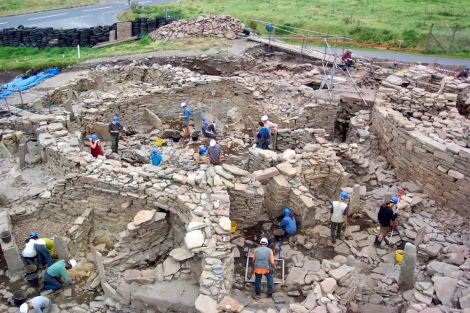Community / Trust keen to hear islanders’ views on the future of Scatness Iron Age site
SHETLAND Amenity Trust continued with its effort to determine the long-term future of its Scatness with a consultation session at the Shetland Museum this week.
Described as the best example for an Iron Age village and broch, the site at the southend of Shetland has become unstable and needs work done to it.
At the same time, the broch and Iron Age village is a candidate to become a UNESCO World Heritage Site.
Shetland regional archaeologist Val Turner told the meeting on Wednesday night: “We want to ensure that whatever we do with the Scatness site, it’s sustainable for the long-term while also protecting it.”
She presented a variety of ideas for handling the site in the future which included the option to re-bury and preserve it, or to construct a building around the area with a turf roof to protect it from the elements.
However, when this was first considered around 2013, it also came with an approximate £12 million price tag.
After exposure to the air, the site in slowly deteriorating, some walls have fallen, and stonework is cracking.
The area of the broch first discovered is of particular concern regarding its stability. Vegetation has also self-seeded in the walls, and birds use the gaps in the stonework to nest in. Frequent stormy and rainy weather during the Shetland winters have also had an impact.
A series of free guided tours around the site were offered in April where the public were invited to give feedback on how Scatness could be improved.
The public were being asked about the value of Scatness, what needs for the South Mainland could be met by the historic location, and how could Betty Mouat’s böd be used to facilitate this. People were also asked to consider what would encourage them to visit the site more frequently.
Become a member of Shetland News
Suggestions included a more accessible car park, a café or coffee shop, better toilets, and longer opening hours. Currently, guided tours are available throughout the summer months on a Friday only, and can be booked via the Shetland Amenity Trust website.
There are some restrictions to further development on the site as there is still so much archaeology underground that could be damaged.
The trust considers the opinion of Shetland locals and visitors essential to the project, Turner said.
“We are looking after the archaeology on behalf of the people of Shetland. Not only the people who live here now, but on behalf of the people who will live here in the next 200 years.”
Conservation engineers have also visited the site and will be reporting back their best options which will be considered alongside the public consultations.
The Old Scatness Broch was first discovered in 1975 by accident during the construction of a road. A JCB digger unearthed some stone and museum curator at the time, Tom Henderson, identified it as a broch and the road was re-routed.
Excavations began in 1995 when the Shetland Amenity Trust purchased Betty Mouat’s cottage to turn it into a böd. Turner added: “Absolutely nothing prepared us for what we were going to find.”
The Scatness dig site offered fresh insight into the origins of brochs due to the multiple innovative dating techniques used in the excavations.
Grain was found in the foundation level of the Scatness broch dated back to 2000 BC. A leg bone of a sheep was also discovered, which the team jokingly referred to as a ‘workman’s lunch’ while the broch was being constructed.
One of the dating techniques used pioneered the way forward for archaeological dating techniques at other excavations. Optically stimulated luminescence (OSL) dating was used to measure when the last time a grain of quartz was exposed to light.
Oxford University carried out an OSL project on the Scatness site during excavations. Turner explained: “It worked quite remarkably, and it’s now a dating mechanism archaeologists are using quite routinely.”
She added: “It’s great because in many early prehistoric sites in the hills of Shetland, there’s often nothing datable in them. But this gives us a new way of doing things which is so exciting.”
Further consultations are due with local community councils in Sandwick and Dunrossness before a survey will be put online later in the year.
Anyone with views on the site can also contact info@shetlandamenity.org to offer their opinions.
Become a member of Shetland News
Shetland News is asking its many readers to consider paying for membership to get additional features and services: -
- Remove non-local ads;
- Bookmark posts to read later;
- Exclusive curated weekly newsletter;
- Hide membership messages;
- Comments open for discussion.
If you appreciate what we do and feel strongly about impartial local journalism, then please become a member of Shetland News by either making a single payment, or setting up a monthly, quarterly or yearly subscription.












































































